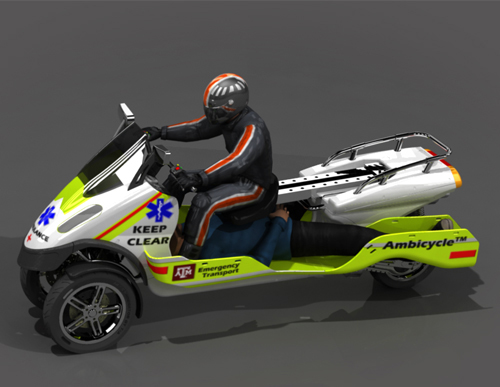Emergency AmbiCycle™ designed to save lives in tight spots

 From small villages with long dirt roads to crowded cities with traffic at a standstill, maneuvering today’s ambulance during an emergency simply may not be an option. But promptly reaching patients to treat them effectively is nonnegotiable.
From small villages with long dirt roads to crowded cities with traffic at a standstill, maneuvering today’s ambulance during an emergency simply may not be an option. But promptly reaching patients to treat them effectively is nonnegotiable.
That’s where the AmbiCycle™ comes in. An alternative compact transportation device specifically designed to transport patients from the scene to the hospital, the AmbiCycle™ is about the width of a Harley-Davidson motorcycle, nine feet long and has three wheels.
Mark Benden, Ph.D., CPE, associate professor at the Texas A&M Health Science Center School of Public Health, and Eric Wilke, M.D., medical director at the College Station Fire Department, began design efforts on the AmbiCycle™ in the summer of 2008. During a volunteer medical trip to Uganda a few months earlier, Wilke saw a need for an emergency transportation vehicle that could navigate crowded and narrow streets in rural areas.
Ambulances in the US are typically around 20 feet long, eight feet high and struggle to maneuver through congested traffic. These bulky vehicles also face difficulties getting to patients in rural areas fast enough, sometimes taking more than 30 minutes to arrive. Alternatives to traditional ambulances have been attempted for rural and metropolitan areas in the past, however they have produced major setbacks. Trailers attached to bikes were not safe on modern roads among motorized traffic, while motorcycle sidecars had a width almost equal to a car and were difficult to maneuver.

“Unlike traditional ambulances, the AmbiCycle™ becomes more stable to drive once a patient is loaded,” said Benden. “Other emergency vehicles have the opposite effect.”
Due to its compact body, the AmbiCycle™ has more stability, allowing the driver and patient to be on the same plane and maintain visual contact. This small device is designed to evacuate patients from areas at risk, damaged by storms, and under heavy traffic with inadequate emergency medical services.
Over the last year Texas A&M engineering students have worked with Benden and Wilke to make significant enhancements to the AmbiCycle™ in an effort to improve patient care and extend the areas the device can reach. With the driver’s helmet now equipped with patient wireless vital sign monitoring and audible alarms when unsafe vital sign levels are registered, emergency care providers can maintain proper care of their patients while in transport.
“With the latest upgrades in wireless patient monitoring and audible driver notifications and alarms by Texas A&M biomedical engineering students, and an improved seat design that doubles as a patient cover by engineering technology students, we are now making significant strides towards our goal of bringing the AmbiCycle™ to patients in need,” said Benden.
“The next step for the continued development of the AmbiCycle™ is to determine any potential military and disaster applications such as off-road and even helicopter transported versions,” said Wilke.
Such an application would involve drone or autonomous versions of the AmbiCycle™ that can drive themselves to patients and caregivers in need of transportation in hazardous areas. Additionally, 36 cycles can fit onto a single 53-foot trailer, making it ideal to store for disaster relief or use in military wounded soldier transport.
“The idea at this point is to produce a scalable, deployable vehicle that can be affordable at purchase and during maintenance,” said Benden. “We hope this evacuation solution will save lives all over the world.”
Media contact: media@tamu.edu


